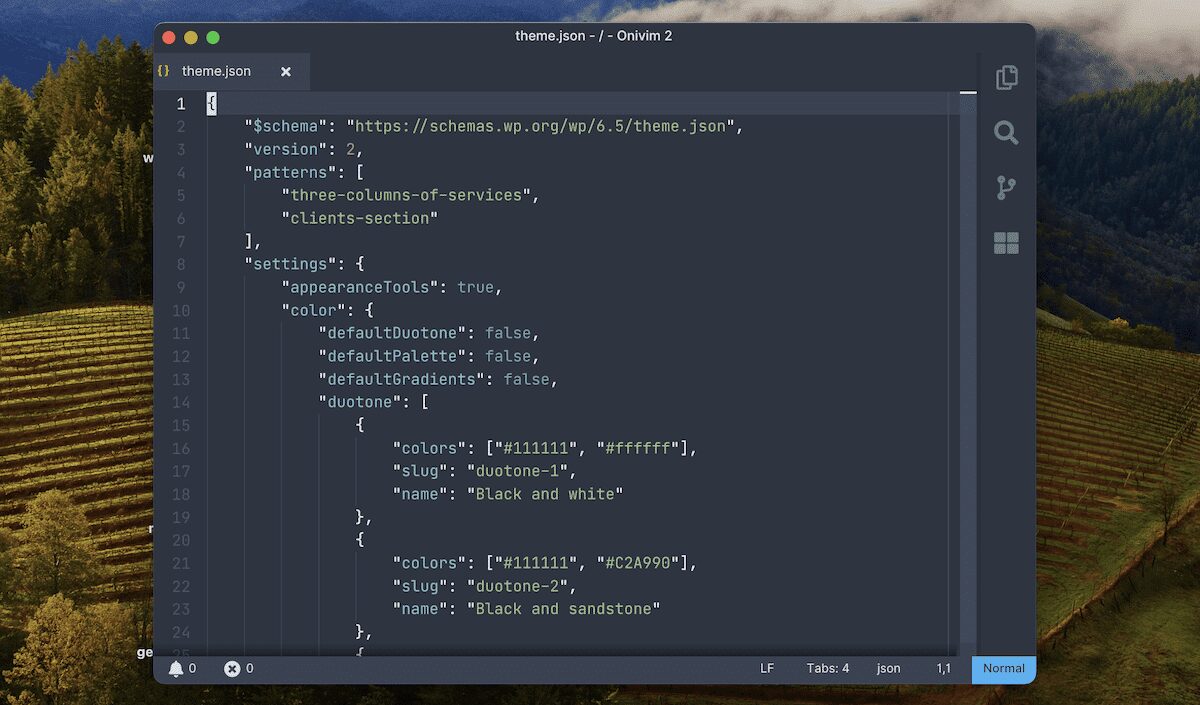wordpress theme developers can use a theme.json report back to streamline a process that used to rely largely on PHP. Then again, you’ll have the ability to however use your HTML, JavaScript, and PHP abilities to build your matter issues — and CSS isn’t any exception. In fact, you utilize CSS custom properties inside of theme.json. It’s going to support the design stage and offer greater flexibility.
In this data, we tackle CSS custom properties head-on to find how they art work alongside wordpress and theme.json. On the other hand quicker than we get there, let’s summarize theme.json, whole internet website editing (FSE), and the best way CSS fits into this new design manner.
How theme.json works with wordpress
The theme.json file first appeared in wordpress 5.8. It’s a innovative approach to design wordpress matter issues, using JSON syntax to construct a configuration report. wordpress reads this and applies the results without the will for some distance PHP, CSS, or JavaScript.
The world settings and kinds inside of FSE control various visual aspects of your theme. The ones can include same old shade palettes and typography, on the other hand they may be able to moreover include layout alternatives and individual Block and phase sorts.
While FSE is intuitive, difficult, adaptable, and easy to use, theme.json can have the same opinion bridge the gap between the end individual and developer roles. Just about each chance theme.json will give you may be visible all the way through the Web page Editor.
 wordpress Site Editor interface, showing the home page of a website on the right-hand side of the screen, while the black, left-hand sidebar gives options for navigation, styles, pages, templates, and patterns.” width=”1200″ height=”750″/>
wordpress Site Editor interface, showing the home page of a website on the right-hand side of the screen, while the black, left-hand sidebar gives options for navigation, styles, pages, templates, and patterns.” width=”1200″ height=”750″/>The use of theme.json supplies many advantages when development wordpress subject matters. There are a few reasons for this:
- You might have a central location to your theme’s design configuration, which makes it easier to control and exchange.
- There’s a lot much less obfuscation between the front-end experience, Web page Editor, and a theme’s codebase.
- The use of
theme.jsonsupplies compatibility with the future of wordpress development and design. - The built-in capacity of wordpress means you reduce the will for the individual to make use of custom CSS.
Let’s take a look at how theme.json relates to FSE’s global settings and types.
A primer on FSE’s International Settings and Types
FSE represents a brand spanking new era of wordpress theme development, and International Settings and Types are at the forefront. This allows consumers to customize just about each facet of a internet website’s glance all the way through the Web page Editor capacity.
 wordpress Site Editor showing the Styles panel’s input fields in the right-hand sidebar. It lets you make adjustments to typography settings. The left-hand side shows a partial view of a blue-themed webpage.” width=”1200″ height=”863″/>
wordpress Site Editor showing the Styles panel’s input fields in the right-hand sidebar. It lets you make adjustments to typography settings. The left-hand side shows a partial view of a blue-themed webpage.” width=”1200″ height=”863″/>Proper right here, you’ll have the ability to modify aspects of your theme’s layout with alternatives that used to require CSS or a third-party web page builder plugin. Improving margins, padding, and borders are examples, on the other hand there are rather a lot additional.
 wordpress Site Editor, showing the Layout customization panel. It lets you customize content dimensions, padding, and block spacing. The left-hand side of the screen shows a partial view of a blue-themed webpage.” width=”1200″ height=”842″/>
wordpress Site Editor, showing the Layout customization panel. It lets you customize content dimensions, padding, and block spacing. The left-hand side of the screen shows a partial view of a blue-themed webpage.” width=”1200″ height=”842″/>You’ll have the ability to even allow or disable a large number of this capacity inside of theme.json (or a Block’s private block.json file). This is helping UI customization alongside the overall internet website design.
Then again, the decisions at your disposal — while intensive — would perhaps now not quilt each need. It is extremely true when you assemble a theme from scratch. This is one process CSS custom properties can have the same opinion get to the bottom of.
Understanding CSS custom properties
In PHP, JavaScript, and just about each programming language, variables hold the values of various parts on your code. For example, you’ll have the ability to store values harking back to names, dates, and numbers and use them all over your program.
CSS3 variables — or CSS custom properties as we call them all over this put up — are supported by means of most present browsers. Internet Explorer doesn’t strengthen them, nor does Opera Mini. Nevertheless, the primary gamers all do.

CSS custom properties mean you can store values to reuse all over your stylesheet. It’s a powerful approach to create additional dynamic and flexible CSS. You’ll have the ability to exchange a few style rules by way of changing a single price.
The concept of CSS variables isn’t utterly new. Preprocessors harking back to Sass use an identical capacity. For example, take the following Sass:
$font-stack: Helvetica, sans-serif
$primary-color: #333
body
font: 100% $font-stack
shade: $primary-colorThis processes into same old CSS:
body {
font: 100% Helvetica, sans-serif;
shade: #333;
}Then again, CSS custom properties take this at once to the browser. This offers some advantages:
- Dynamic updates. By contrast to most preprocessor variables, you’ll have the ability to exchange CSS custom properties “on the fly” using JavaScript.
- Cascading nature. Custom designed properties will follow the CSS cascade, which will give you greater flexibility and further context-aware styling.
Custom designed properties will also be additional performant by way of reducing code redundancy. Smaller stylesheets indicate sooner loading circumstances.
The syntax for CSS custom properties
As with same old preprocessor variables, the syntax for CSS custom properties is discreet. It uses double hyphens reasonably than dollar signs to specify a property:
:root {
--primary-color: #007bff;
}From there, you utilize the var() function to assign those properties to parts:
.button {
background-color: var(--primary-color);
}Understand that you simply’ll have the ability to moreover assign custom properties using the @ property. Then again, as you’ll understand shortly, wordpress simplifies this complete process.
Where you’ll have the ability to use CSS custom properties
Versatility is the order of the day in the case of CSS custom properties. With wordpress and theme.jsonYou might have a few tactics to use them:
- Presets: You’ll have the ability to define shade, font, and spacing presets.
- Block sorts: Person Blocks can use custom properties for consistent styling.
- International sorts: Custom designed properties are useful for site-wide design.
You’ll have the ability to create completely custom properties for regardless of objective you wish to have. Let’s check out a wise example of the best way you could use custom properties on your theme.json file:
{
"settings": {
"shade": {
"palette": [
{
"slug": "primary",
"color": "#007bff",
"name": "Primary"
}
]
},
"custom": {
"line-height": {
"body": 1.5,
"heading": 1.2
}
}
},
"sorts": {
"typography": {
"lineHeight": "var(--wp--custom--line-height--body)"
},
"blocks": {
"core/heading": {
"typography": {
"lineHeight": "var(--wp--custom--line-height--heading)"
}
}
}
}
}Proper right here, we define a color preset and use the custom property to stipulate line-height values for the pages headings and body. wordpress will generate CSS properties for the elements you define using custom. Further down, we can assign the ones custom properties to various sorts, settings, Blocks, and further.
Some great benefits of using CSS custom properties
Chances are high that you’ll already have ideas about how CSS custom properties let you when growing matter issues. Even so, there are lots of benefits to note.
We already discuss modularity and reusability. All of the common values you define as custom properties will put it on the market consistency and reduce redundancy. That redundancy will translate into upper doable efficiency to your theme.
For the end individual, custom properties provide an a variety of benefits:
- Simplified customization. Consumers and internet website householders can customise a theme without the will for classy CSS knowledge. On every occasion you reveal variables through
theme.json, consumers can get entry to the settings all the way through the Web page Editor. - Upper compatibility with FSE. Custom designed properties align with FSE regulations, allowing you to create additional flexible and dynamic theme designs.
- More straightforward maintenance and updates. If you wish to exchange common values all the way through your theme, a practice property means changing it in just one place. It streamlines your maintenance and makes updates and tweaks additional manageable.
General, custom properties can support your theme development workflow. Understanding them may be easier than using same old CSS variables.
define CSS custom properties inside of theme.json
Let’s get into the practical aspects of defining and using CSS custom properties inside of theme.json. The first step is learning simple the best way to write them.
Syntax and naming conventions
wordpress supplies the custom property to have the same opinion with definitions. This is slightly easier to use than the @ property or definitions inside of pseudo classes, and uses the standard key/price structure:
{
"settings": {
"custom": {
"property-name": "price"
}
}
}Behind the scenes, wordpress will process this definition and generate a CSS custom property using double hyphens:
--wp--custom----wp--custom-- will at all times be a part of your CSS property, and it won’t use camel case. For example, when you define lineHeight as a practice property, wordpress will turn it into “kebab case:”
--wp--custom--line-heightOn the subject of naming conventions, you’ll have the ability to use camel case if you wish to have, despite the fact that we propose kebab case to your custom property names. This is consistent with wordpress’s naming conventions, improves readability, and cuts down on processing errors.
Understand: CSS custom properties use double hyphens given that W3C’s CSS Operating Workforce moreover must encourage you to use Sass (which makes use of greenback signs to stipulate properties). This manner, you’ve gotten the collection of each and every to support your designs.
wordpress already defines some custom properties — or no less than, matter issues have that chance to do so. This means you’ll see CSS variables inside of theme.json without an explicit declaration:
{
"settings": {
"shade": {
"palette": [
{
"slug": "primary",
"color": "var(--wp--preset--color--primary)",
"name": "Primary"
}
]
},
"custom": {
"spacing": {
"small": "1rem",
"medium": "2rem",
"large": "3rem"
}
}
},
"sorts": {
"spacing": {
"blockGap": "var(--wp--custom--spacing--medium)"
}
}
}In this example, we define a primary shade using an provide preset shade. Then, we define some custom spacing properties and then set them using var().
This means we don’t want to hard-code values into theme.json. What’s additional, consumers can exchange the ones values all the way through the Web page Editor and have them propagate all over the theme.
Presets vs. custom properties
Actually, theme.json moreover lets you define presets for colors, font sizes, and other common theme parts. On the other hand, you’ll have the ability to use custom properties for any price you need to reuse all over your theme.
A very powerful difference that is in naming conventions and accessibility. Consumers won’t have the ability to get entry to custom properties throughout the Web page Editor without further art work to your end. With presets, wordpress will generate CSS that looks similar to how it processes custom properties:
{
"settings": {
"shade": {
"palette": [
{
"slug": "primary",
"color": "#007bff",
"name": "Primary"
}
]
},
"custom": {
"fontFamily": {
"base": "-apple-system, BlinkMacSystemFont, 'Segoe UI', Roboto, Oxygen-Sans, Ubuntu, Cantarell, 'Helvetica Neue', sans-serif",
"headings": "'Helvetica Neue', Helvetica, Arial, sans-serif"
}
}
}
}Once wordpress processes this, you’ll have the ability to see the inherent diversifications:
--wp--preset--primary: #007bff;
--wp--custom--font-family--base: "-apple-system, BlinkMacSystemFont, 'Segoe UI', Roboto, Oxygen-Sans, Ubuntu, Cantarell, 'Helvetica Neue', sans-serif";
--wp--custom--font-family--headings: "'Helvetica Neue', Helvetica, Arial, sans-serif";Notice that further property nesting will use double hyphens, even after converting camel case to kebab case.
International and Block-specific CSS versus CSS custom properties
With antique wordpress, you perhaps can use further and tradition CSS on the front end to design parts inside of your theme. This is however the case with theme.json and FSE, despite the fact that the process isn’t the similar as CSS custom properties.
While you talk over with the Web page Editor and head into the Types visual display unit, you’ll spot the Additional CSS segment. This acts very similar to a Custom designed CSS panel inside of antique wordpress installations:
 wordpress Site Editor showing links to the Blocks and Additional CSS settings. The left-hand side of the screen displays a partial view of a building against a blue sky.” width=”1200″ height=”587″/>
wordpress Site Editor showing links to the Blocks and Additional CSS settings. The left-hand side of the screen displays a partial view of a building against a blue sky.” width=”1200″ height=”587″/>This represents a way so that you could upload global CSS customization to a theme. Then again, it’s in fact a approach to give consumers the facility so that you could upload CSS. You might also use this to make small, minor changes that don’t warrant an entire stylesheet.
Inside of theme.json, you utilize the css property to stipulate to any extent further CSS you need so that you could upload:
{
"style": 3,
"sorts": {
"css": "margin: 0"
}
}Understand that you just don’t want to use semicolons to complete CSS statements. You’re moreover in a position to set custom CSS for Blocks, too:
{
"style": 2,
"sorts": {
"blocks": {
"core/post-title": {
"css": "letter-spacing: 1px;"
}
}
}
}Any time you set CSS like this inside of theme.json, you’re going to look it inside of any Web page Editor Additional CSS fields. Then again, remember the fact that no longer anything else you declare using css is a CSS custom property.
The use of the ampersand (&) selector
Very similar to Sass, wordpress moreover is helping the ampersand selector, with a few diversifications. In this case, it’s a great way to concentrate on nested parts and houses. This might be similar if you choose to assert CSS custom properties for individual Blocks.
For example, take the following:
…
"sorts": {
"blocks": {
"core/table": {
"css": "shade:#333 & th{ background:#f5f5f5; }"
}
…This defines a text shade and a background shade to the table header phase. Once wordpress processes it, you get clean, plain CSS:
.wp-block-table > table {
shade: #333;
}
.wp-block-table > table th {
background: #f5f5f5;
}Ampersand selectors are very good if you wish to lengthen the CSS you objective. An understandable technique to imagine the selector is that it’s serving to separate your CSS parts. Take the following, for instance:
{
"style": 3,
"sorts": {
"blocks": {
"core/avatar": {
"css": "& img {border-radius: 999px}"
}
}
}
}This offers a border radius to an avatar and outputs the CSS as you’d expect:
.wp-block-image img {
border-radius: 999px;
}Then again, without the ampersand, wordpress would conjoin your declarations:
…
.wp-block-imageimg
…The use of the ampersand selector to your CSS custom properties will also be something you do steadily.
Kinsta’s serve as in supporting stylish wordpress development
Your number of internet hosting is just as necessary as any coding language, preprocessor, or other technical phase. And no longer the use of a top quality internet hosting provider at your aspect, you won’t have the ability to have the benefit of the potency and toolset of theme.json or FSE.
Kinsta may also be central to all your workflow, as a result of our development apparatus. You’ll have the ability to get began with DevKinsta — our local development surroundings that uses Docker bins to isolate your wordpress arrange:
 wordpress configuration settings. It displays connection details, including host, port, database name, and wordpress version. The interface also shows options to enable debugging and auto-updates for wordpress.” width=”1200″ height=”596″/>
wordpress configuration settings. It displays connection details, including host, port, database name, and wordpress version. The interface also shows options to enable debugging and auto-updates for wordpress.” width=”1200″ height=”596″/>One useful piece of capacity is DevKinsta’s skill to push and pull wisdom between your local instrument and your Kinsta staging environments:
 wordpress admin. A drop-down menu reveals options to push to or pull from Kinsta. The site type is listed as wordpress, with visible yet partial information about the host.” width=”1200″ height=”354″/>
wordpress admin. A drop-down menu reveals options to push to or pull from Kinsta. The site type is listed as wordpress, with visible yet partial information about the host.” width=”1200″ height=”354″/>This allows you to test your matter issues in a production-like environment quicker than you begin to distribute them. When working with CSS custom properties, you’ll have the ability to be sure that they art work all the way through different contexts. Kinsta’s API can strengthen your CI/CD pipeline whilst you’re ready to go live.
Other aspects of Kinsta’s construction will mean you can all the way through all your development setup. For example, Kinsta is helping Git, which makes it easy to style control your theme files, along side theme.json. For iterating custom properties, or simply experimenting with different configurations, you’ll want to know you’ve gotten a rollback chance.
In spite of everything, if you choose to use your theme on a Kinsta server, our Edge Caching will building up the potency of theme.json by way of up to 80 %. Having a internet web page that runs speedy without reference to the individual’s browser will ensure that those custom additions display promptly.
Summary
Merely as theme.json is a powerful configuration file for rising flexible and maintainable wordpress matter issues, CSS custom properties are an important to the workflow. That’s the manner you’ll assemble and declare CSS for parts the Web page Editor doesn’t reach. It’ll also be key when you assemble your individual Blocks or simply want to expand unique wordpress matter issues with the ultimate customization depth. What’s additional, you moreover find a way to percentage that CSS with consumers all the way through the Web page Editor.
Will CSS custom properties be a part of your theme development workflow? If so, how will you use them? Proportion your insights throughout the comments segment beneath!
The put up Creating CSS tradition homes with theme.json for enhanced wordpress subject matters appeared first on Kinsta®.
WP hosting
[ continue ]
wordpress Maintenance Plans | wordpress hosting
read more
wordpress-subject-matters/”>Source link













